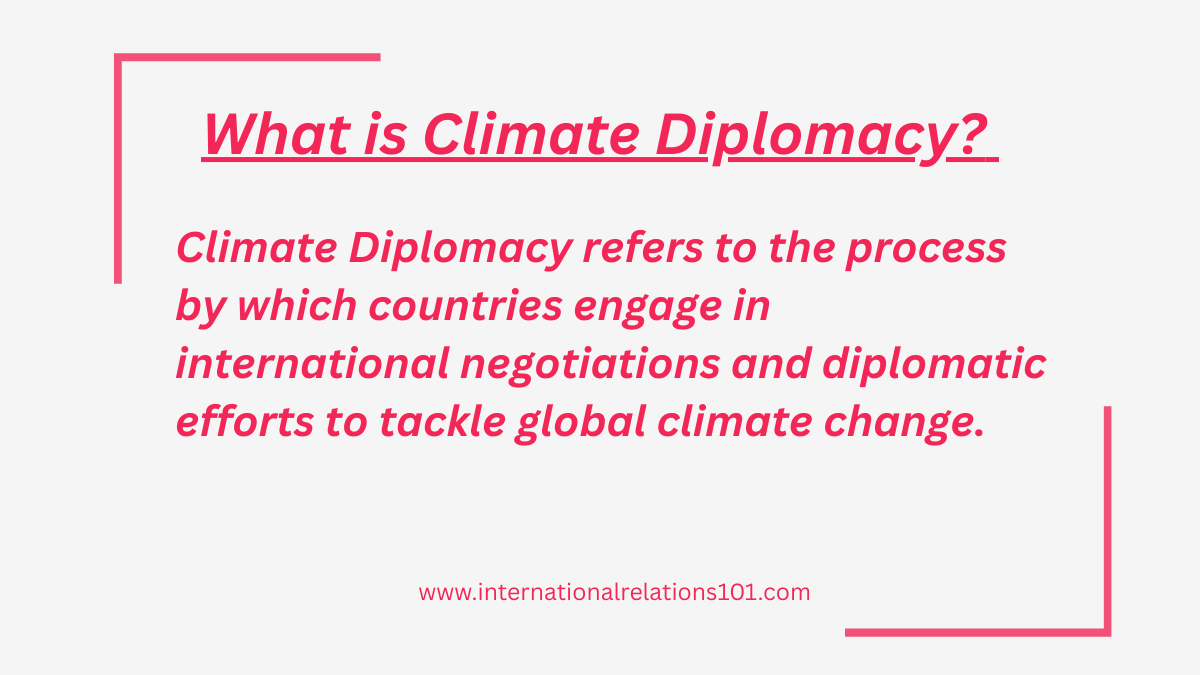What is Climate Diplomacy?
Climate Diplomacy refers to the process by which countries engage in international negotiations and diplomatic efforts to tackle global climate change. It involves:
– Negotiating agreements (like the Paris Agreement)
– Promoting sustainable development
– Balancing national interests with global responsibility
It lies at the intersection of international relations, environmental policy, and global governance.

Table of Contents
Key Milestones in Global Climate Diplomacy
| Year | Event | Significance |
| 1992 | UNFCCC (Rio Earth Summit) | Framework for future climate talks |
| 1997 | Kyoto Protocol | Legally binding targets for developed nations |
| 2015 | Paris Agreement | First universal climate deal |
| 2023 | COP28, UAE | Discussions on phasing out fossil fuels |
India’s Role in Climate Diplomacy
India is a key player in international climate negotiations due to:
– Its size and emissions profile
– Developmental needs
– Commitment to renewable energy
Major Contributions:
- International Solar Alliance (ISA): Co-founded with France to promote solar power.
- Mission LiFE: Lifestyle for Environment initiative launched at COP27.
- Updated NDCs: India pledged to reduce emissions intensity by 45% (by 2030) and achieve 50% cumulative electricity from renewables.
“India has always advocated climate justice and common but differentiated responsibilities (CBDR).“
Key Principles of Climate Diplomacy
- CBDR-RC: Common but Differentiated Responsibilities and Respective Capabilities
- Climate Justice
- Equity and Fairness
- Technology Transfer & Finance
Challenges in Climate Diplomacy
- North-South Divide: Developed nations push ambitious targets while developing nations seek climate finance.
- Lack of Binding Enforcement: The Paris Agreement is largely voluntary.
- Geopolitical Tensions: US-China competition impacts climate cooperation.
- Greenwashing & Hypocrisy: Countries make promises but delay real action.
Recent Developments (2022–2025)
- COP27- 2022, Sharm el-Sheikh, Egypt :
Established a dedicated fund for loss and damage, maintained the 1.5°C target, and shifted focus from promises to action.
- COP28 -2023, Dubai, UAE :
Adopted a “global stocktake” recognizing the need for deep emissions reductions to limit warming to 1.5°C, including calls for tripling renewable energy capacity and doubling energy efficiency by 2030.
- COP29 -2024, Baku, Azerbaijan:
Successfully convened nearly all nations, with key outcomes including a new global climate finance goal and the operationalization of the Loss and Damage Fund.
- COP30 -2025, Belém, Brazil:
Scheduled to further address climate change, with a focus on advancing human rights-based solutions

Climate Diplomacy & UPSC Relevance
- Prelims:
- Questions on climate treaties (Kyoto, Paris, COP)
- India’s NDC targets, organizations like ISA
- Mains:
- GS Paper 2: India’s foreign policy and global climate governance
- GS Paper 3: Environmental issues, sustainable development
Sample Question: “Critically analyze India’s approach to climate diplomacy in the context of its developmental needs and global commitments.”
FAQ on Climate Diplomacy
What is climate diplomacy?
It refers to the diplomatic efforts by nations to address climate change through international negotiations and cooperation.
How is India contributing to climate diplomacy?
Through initiatives like the International Solar Alliance, updated NDCs, and advocacy for climate justice.
Why is climate diplomacy important for UPSC?
It connects international relations, environment, and policy—key areas in GS Papers 2 and 3.
Related Articles
- Sustainable Development Goals: A Blueprint for a Better Future
- What is COP: The Conference of the Parties
Sources
- https://unfccc.int/
- IPCC Reports
- Press Information Bureau (PIB) India
- COP27 & COP28 Summaries